When it comes to tattoos, serpent tattoo designs are among the most popular choices. Serpents have always played a prominent role in mythology, religion, and symbolism across different cultures and time periods. Thus, serpent tattoos have a rich history and deep meanings that make them a meaningful choice for many people. In this article with Impeccable Nest, we will explore the symbolism and meaning of serpent tattoo.
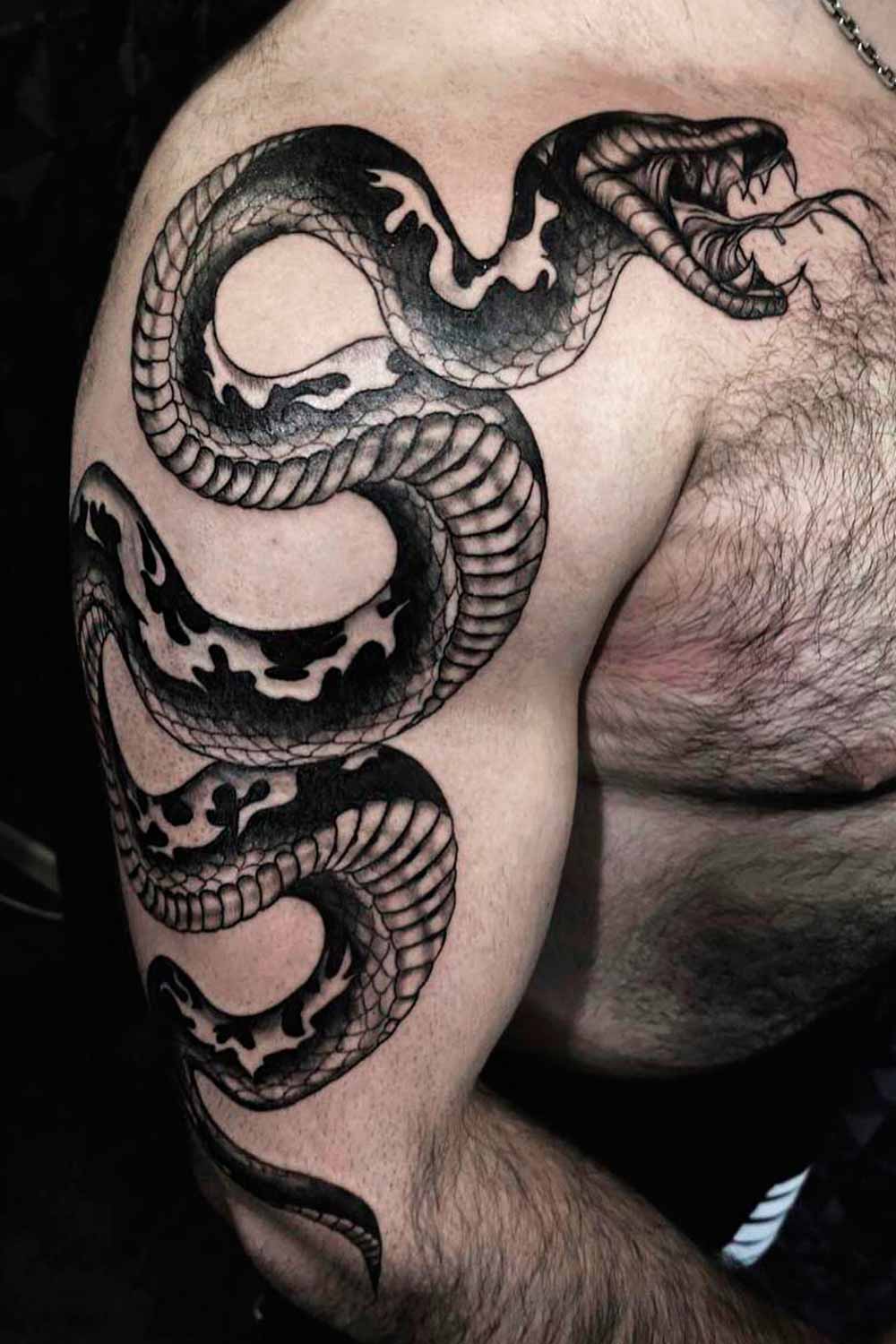
The Historical Significance of Serpent Tattoos
The history of serpent tattoos dates back to ancient times when humans worshipped nature and its elements. The serpent was one such creature that commanded reverence due to its ability to shed its skin and emerge renewed. In many cultures, serpents were linked with fertility, rebirth, and transformation. For instance, in ancient Egypt, the goddess Wadjet was depicted as a cobra whose venom could heal or harm depending on how it was wielded. Similarly, in Greek mythology, Asclepius, the god of medicine, held a staff with a serpent coiled around it, signifying healing and rejuvenation.
As time progressed, the symbolic significance of serpent tattoos evolved, taking on new meanings in different contexts. In the Middle Ages, serpents became associated with sin and temptation, thanks to the biblical story of Adam and Eve. However, in some Asian cultures, such as Japan, serpents are still considered protectors against misfortune and evil spirits.
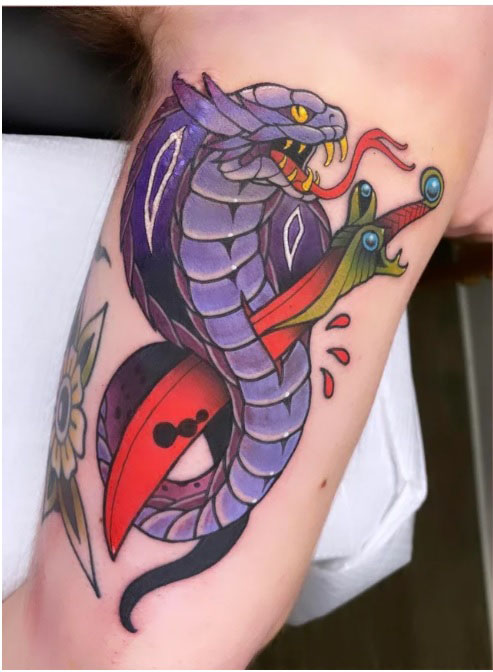
Serpent Tattoo Meaning: What is the Significance?
Serpents have been associated with various meanings throughout history. Some of the most common serpent tattoo meanings are as follows:
Rebirth and Renewal
The serpent has always been a significant symbol in various cultures and mythologies. It is often associated with transformation, wisdom, healing, and renewal. The shedding of its skin is a process that symbolizes the cycle of life, death, and rebirth. As such, many people choose to get a serpent tattoo to represent a new beginning or chapter in their lives.
For those who have experienced difficult periods in their life, the serpent tattoo can be a powerful reminder that they too can shed their old skin and emerge stronger and renewed. It can serve as a symbol of their resilience, strength, and ability to overcome challenges. This may be particularly relevant for those who have gone through traumatic experiences, such as abuse, addiction or illness, and are looking to reclaim their sense of self.
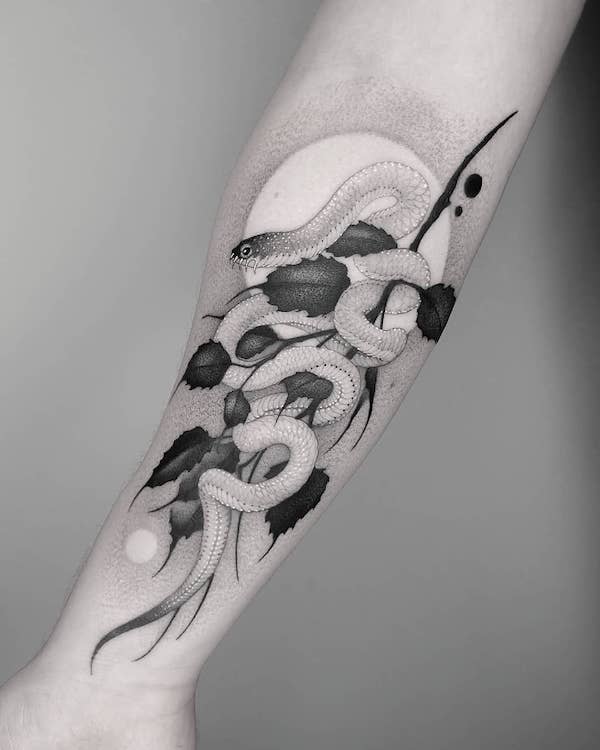
In addition to representing personal growth and renewal, the serpent tattoo can also be a symbol of spiritual awakening. In many belief systems, snakes are associated with spiritual energy, transformation, and divine knowledge. For example, in Hindu mythology, the Kundalini serpent represents the spiritual energy within all of us that needs to be awakened and channeled to achieve enlightenment.
Overall, the serpent tattoo is a powerful symbol that can hold different meanings for different people. Whether it is a representation of personal growth, resilience, or spirituality, it is a beautiful and meaningful way to celebrate the journey of life and all its ups and downs.
Wisdom and Knowledge
In ancient Greek mythology, the serpent was a creature that often represented knowledge and wisdom. It was viewed as a symbol of transformation, rebirth, and healing due to its ability to shed its skin and emerge renewed. The serpent’s association with medicine and healing can be traced back to the Greek god of medicine, Asclepius.
Asclepius was the son of Apollo and a mortal woman named Coronis. He was said to have been taught the art of healing by the centaur Chiron and became a renowned healer who could even bring people back from the dead. Asclepius was so successful in his healing that he was eventually elevated to the status of a god.

The symbol most commonly associated with Asclepius is the Rod of Asclepius. This symbol features a staff that is entwined by a serpent, with the serpent’s head typically positioned above the staff. The Rod of Asclepius has been used for centuries as a symbol of medicine and healthcare.
The Rod of Asclepius represents the idea of healing and renewal that was associated with Asclepius in ancient Greek mythology. The serpent’s ability to shed its skin and emerge renewed represents the concept of healing and rebirth. The staff represents the power of medicine to support the body and promote healing.
The use of the Rod of Asclepius as a symbol of medicine and healthcare can still be seen today. It is commonly used by medical organizations, hospitals, and other healthcare providers as a logo or emblem. It serves as a reminder of the importance of healing and the power of medicine to promote health and well-being.
In conclusion, the serpent’s association with wisdom and knowledge in ancient Greek mythology led to its association with healing and medicine. The Rod of Asclepius, featuring a staff entwined by a serpent, has become a widely recognized symbol of medicine and healthcare, representing the power of medicine to promote healing and renewal.
Transformation and Change
Serpents, also known as snakes, have been a potent symbol across various cultures and religions throughout history. One of the most common interpretations of serpents is their representation of transformation and change. Serpents are creatures that can adapt to their surroundings and overcome obstacles, making them an ideal symbol for personal growth and development.
In ancient Greek mythology, the serpent shedding its skin was interpreted as a symbol of rebirth. The snake’s ability to shed its old skin and emerge anew represented the idea of letting go of the past and embracing new beginnings. This concept has been carried forward, and many people still associate serpents with the idea of personal transformation and growth.

Serpents are often depicted as powerful creatures in art, literature, and mythology. They are considered to be symbols of both good and evil, depending on the context, but their power and resilience are undeniable. People may choose to get serpent tattoos to remind themselves of these qualities and to signify their own personal transformation and change.
The design of the serpent tattoo can vary widely, from simple outlines to intricate, detailed images. Some people may choose to add other symbols or elements to their serpent tattoo, such as flowers, skulls, or other animals. The placement of the tattoo can also vary, with popular locations being the arm, back, and chest.
One of the significant advantages of getting a serpent tattoo is that it can serve as a constant reminder of one’s personal power and potential for growth. Whenever someone sees their tattoo, they may be inspired to continue pushing themselves out of their comfort zone and challenging themselves to become the best version of themselves. It can also serve as a source of strength during difficult times, reminding the wearer of their inner resilience and ability to adapt to any situation.
Protection and Healing
In many cultures around the world, serpents have been associated with various symbolic meanings including protection and healing. This belief is deeply rooted in Hindu mythology where the serpent Adisesha is believed to protect the god Vishnu, one of the most important deities in Hinduism.
According to Hindu mythology, Adisesha is a celestial serpent who supports the entire universe on his thousand hoods. He is also known as Ananta, which means “endless,” and is considered to be the first creature of creation. Adisesha is believed to have a strong connection with Vishnu, who is often depicted lying on the serpent’s coils.
In Hindu culture, serpents are considered to be divine beings and worshipped as such. They are believed to possess great power and possess the ability to protect their devotees from harm and illness. Serpent tattoos are a popular way for people to symbolize their connection to these divine beings and seek their protection.
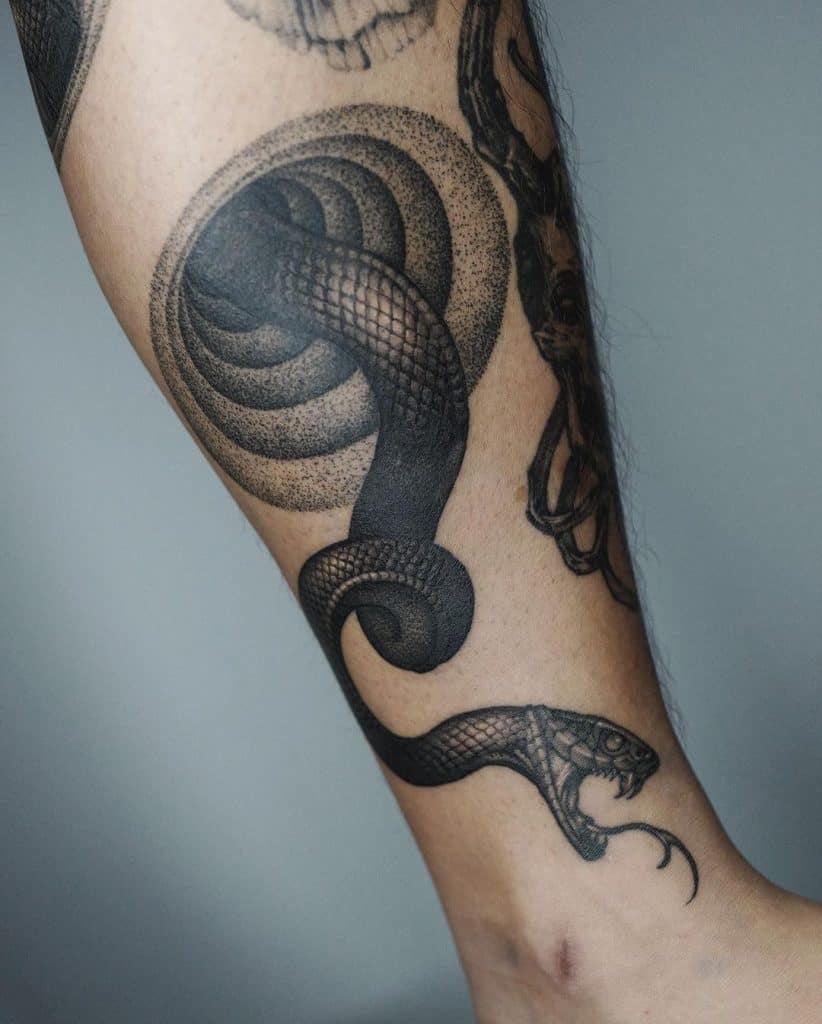
Apart from Hinduism, serpents have been revered in other cultures as well. For example, in ancient Egyptian culture, the serpent was associated with royalty and was believed to protect the pharaohs. In Greek mythology, the serpent was connected with the god of medicine, Asclepius, and was seen as a symbol of healing and regeneration.
In modern times, serpent tattoos have become increasingly popular and are often chosen as a symbol of protection and healing. People get serpent tattoos as a way to connect with the protective powers of these creatures and seek their guidance and strength in times of need. Such tattoos can also serve as a reminder to stay strong and persevere through difficult times.
Life, Death, and Rebirth Cycle
The serpent tattoo has a rich history and is associated with various symbolic meanings across different cultures. In many ancient civilizations, snakes were revered as creatures that possessed otherworldly powers and were revered for their ability to shed their skin and seemingly come back to life.
One of the most commonly associated meanings of a serpent tattoo is the cycle of life, death, and rebirth. The shedding of the snake’s skin is seen as a metaphor for the process of transformation and renewal, representing the cyclical nature of existence. For this reason, it’s not uncommon to see serpent tattoos on individuals who have experienced significant changes in their lives or have overcome difficult challenges.
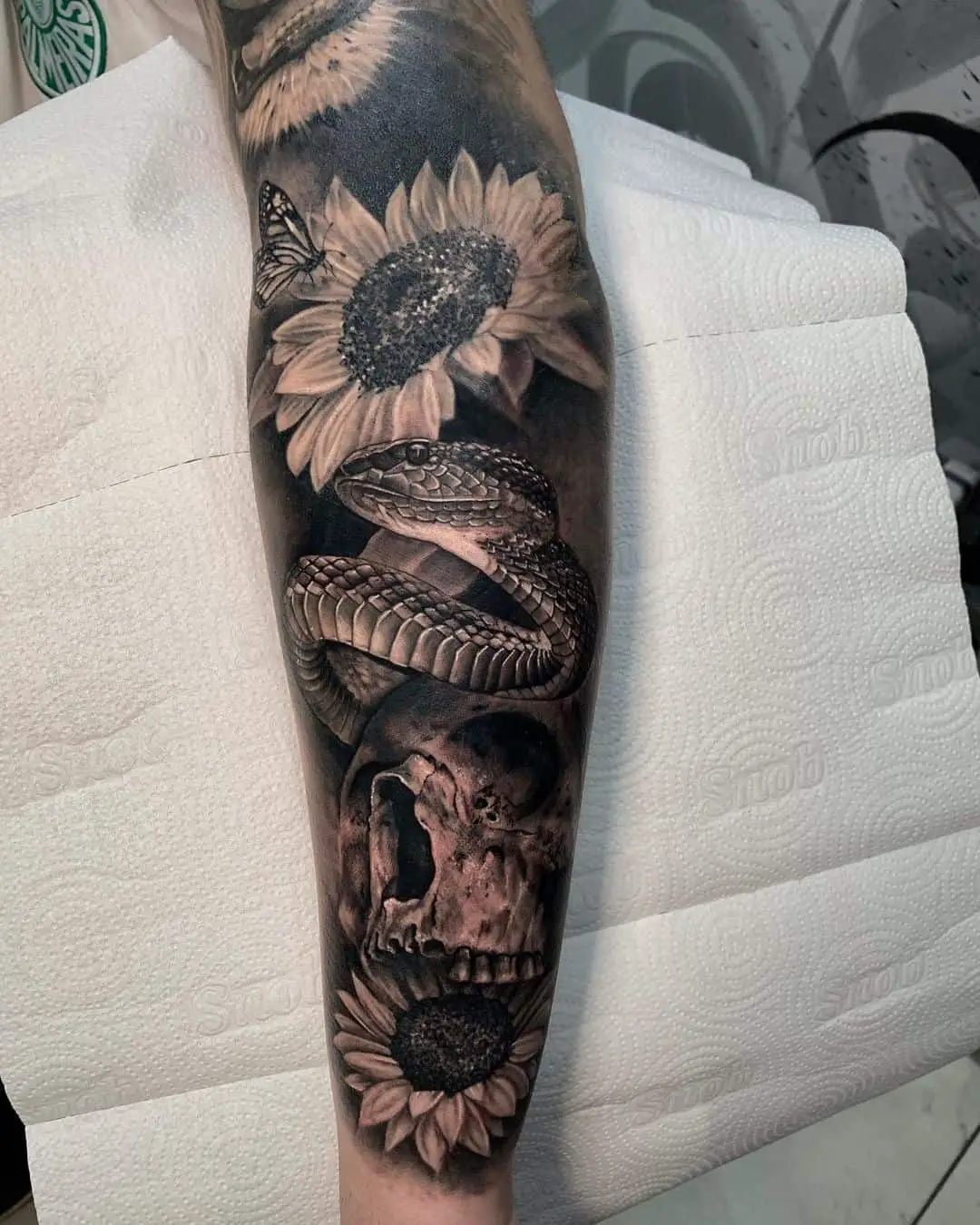
In some cultures, the serpent is also associated with eternal life. This symbolism likely stems from the fact that snakes can live for an exceptionally long time, with some species living for several decades or even centuries. For those who believe in the afterlife, the serpent may represent a guide or protector on the journey to the next world.
In addition to these more existential meanings, the serpent tattoo is also associated with a variety of other symbols and attributes. For example, in many cultures, snakes are seen as guardians of knowledge and wisdom. In ancient Greek mythology, the serpent was associated with healing and medicine, while in Hinduism, the serpent is often seen as a symbol of kundalini energy and spiritual awakening.
Healing and Medicine
Serpent tattoos have been around for centuries and they carry a range of meanings that vary depending on cultural and historical contexts. One of the most common interpretations of the serpent tattoo is its association with healing and medicine. This can be traced back to ancient cultures which saw snakes as symbols of regeneration, renewal, and transformation.
One of the reasons behind this connection between snakes and healing is the snake’s ability to shed its skin. This process was seen as a form of rejuvenation, and it was believed that the snake’s ability to renew itself could be transferred to humans through various forms of magic or ritual. In many cultures, the snake was also associated with the underworld and the afterlife, making it a powerful symbol of death and rebirth.
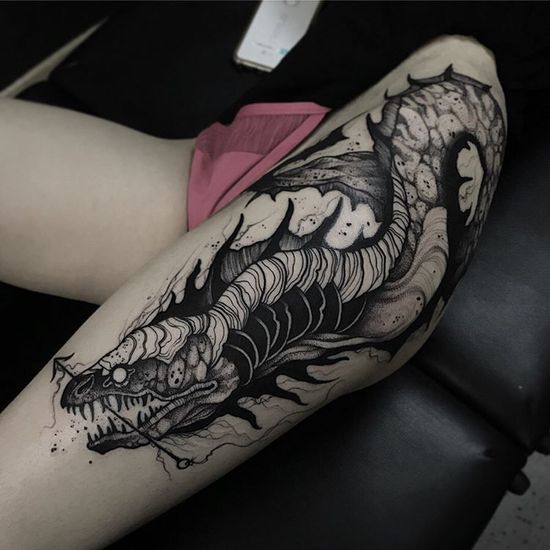
In addition to their regenerative properties, snakes were also believed to possess healing powers. For example, in Greek mythology, the god of medicine, Asclepius, was often depicted with a staff entwined by a single serpent. This symbol, known as the Rod of Asclepius, has become a widely recognized emblem of medicine and healing. The ancient Egyptians also revered snakes for their healing abilities, and they often used snake venom as a form of medicine.
Today, serpent tattoos continue to be popular among those who wish to convey a sense of strength, resilience, and transformation. For some people, the serpent tattoo may represent a personal journey of growth and self-discovery, while for others it may simply be a nod to the rich history and symbolism of the snake. Whatever the reason, the serpent tattoo remains a timeless and powerful symbol that speaks to the enduring human fascination with the mysteries of life, death, and rebirth.
Mysticism and Spirituality
Serpents, or snakes, have been a popular subject of tattoos for centuries. Throughout history, snakes have played an important role in many cultures and traditions, often symbolizing a variety of meanings and representations. In some ancient mythologies, the snake was considered sacred and had a divine status, while in others, it was seen as a symbol of evil and misfortune.
In Hinduism, the serpent is associated with Kundalini energy, which is believed to be the primal energy that resides at the base of the spine. When awakened, this energy travels up the spine and leads to spiritual enlightenment. The snake is also associated with Lord Shiva, who wears a cobra around his neck.
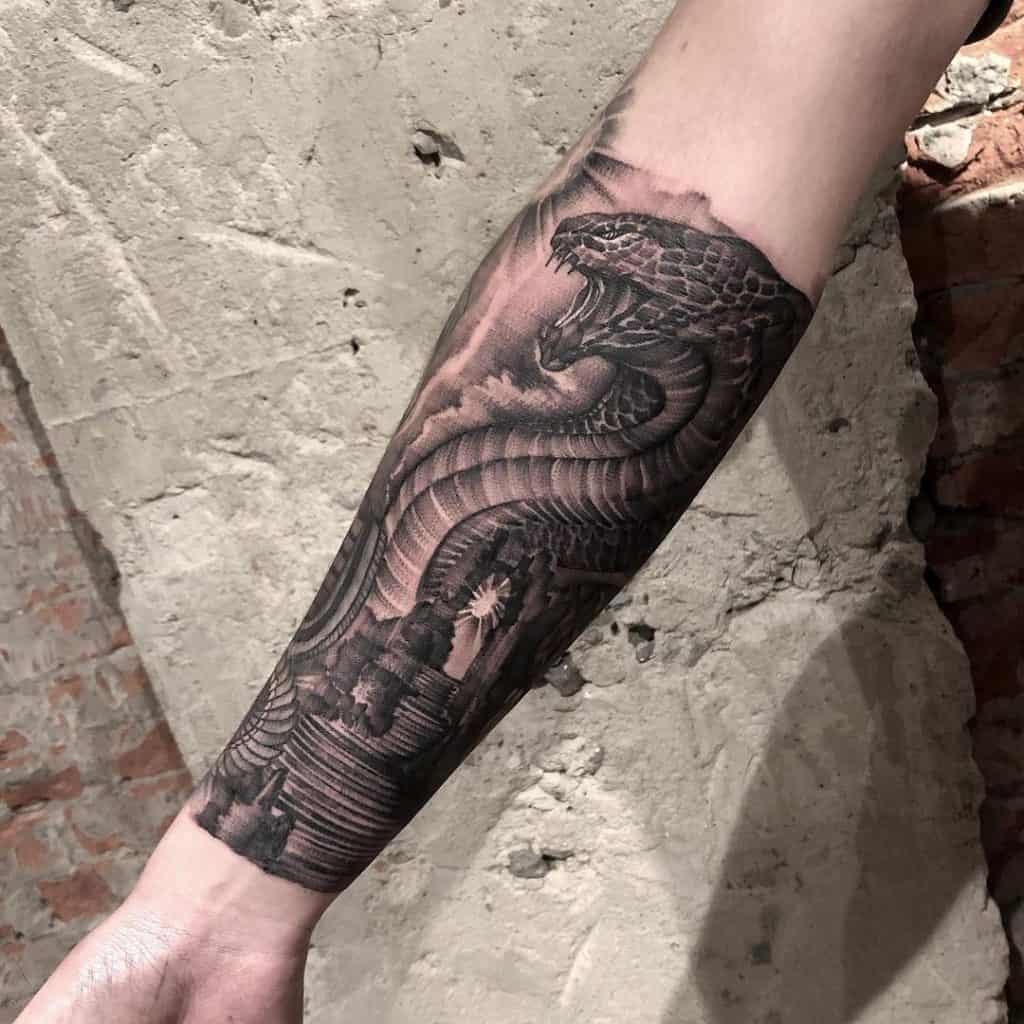
In Greek mythology, the snake is linked to the god of medicine, Asclepius, who used a staff with a snake wrapped around it as a symbol of healing. This symbol, known as the Rod of Asclepius, is still used today as a medical symbol.
In Christianity, the snake is often portrayed as a symbol of temptation or evil due to its association with the Garden of Eden story, where the serpent tempts Eve to eat the forbidden fruit. However, in some sects of Christianity, the snake is also seen as a symbol of salvation and healing, as Moses used a bronze serpent to heal the Israelites from snake bites.
In Native American culture, the snake is often associated with renewal and transformation, as it sheds its skin and appears to be reborn. It is also seen as a symbol of protection and power, as well as a messenger between humans and the spirit world.
Overall, the meaning behind a serpent tattoo can vary depending on the individual’s cultural background and personal beliefs. Some may choose to get a serpent tattoo to represent power, wisdom, rejuvenation, or transformation. Others may use it as a symbol of protection or guidance, while some may simply appreciate the aesthetic beauty of the snake’s intricate designs and patterns.
Serpent Tattoo Designs: Aesthetic Variations
Serpent tattoos come in various designs and styles, making them an excellent choice for people who want a unique and personalized tattoo. Some of the popular serpent tattoo designs are as follows:
Traditional Serpent Tattoos
Traditional serpent tattoos are bold and colorful, often featuring intricate designs and patterns. These tattoos are typically done in a neo-traditional style, which combines traditional tattoo elements with modern techniques.
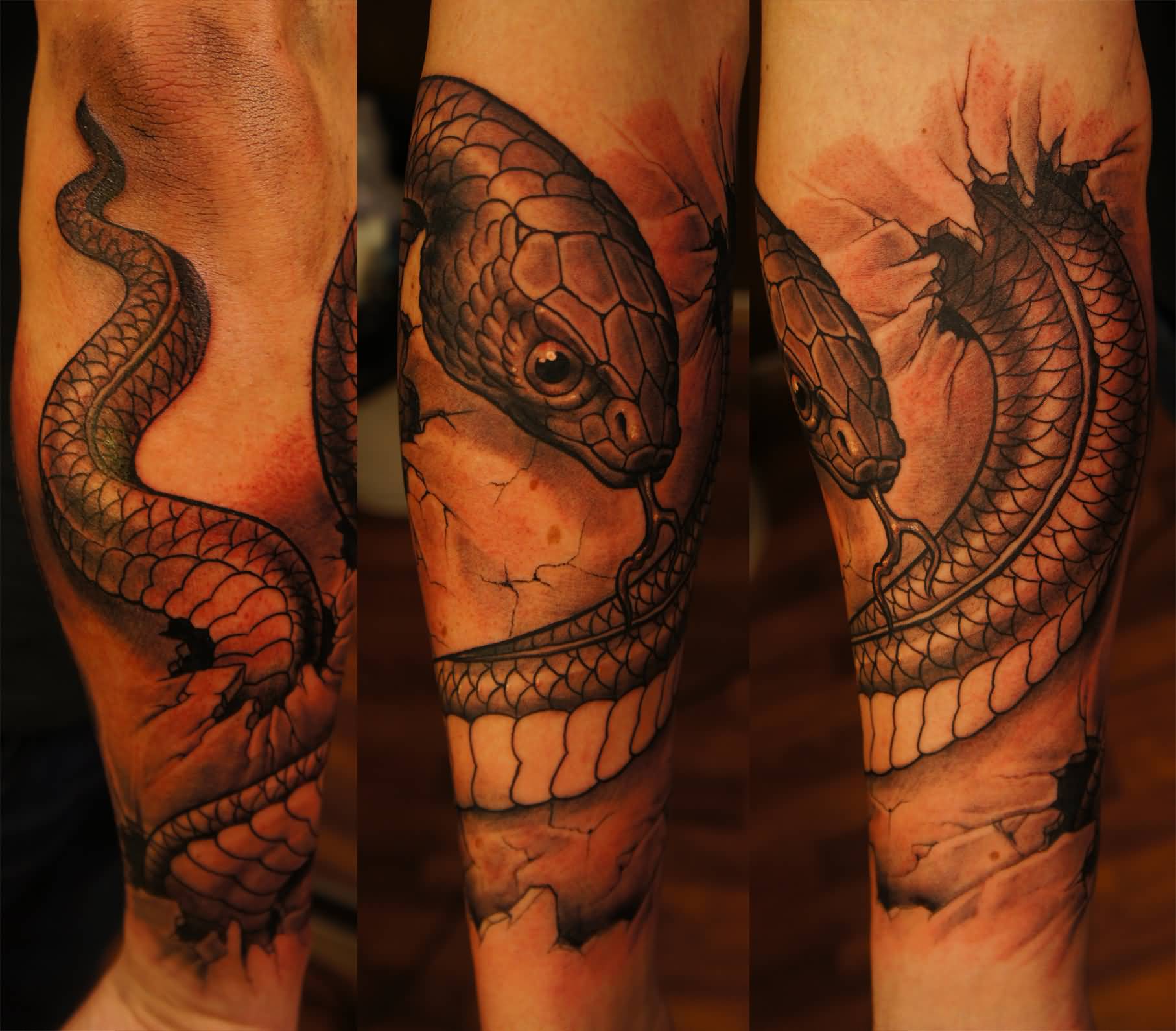
Realistic Serpent Tattoos
Realistic serpent tattoos are highly detailed and lifelike, often featuring shading and texture to create a three-dimensional effect. These tattoos are usually larger and more intricate than other serpent tattoo designs.
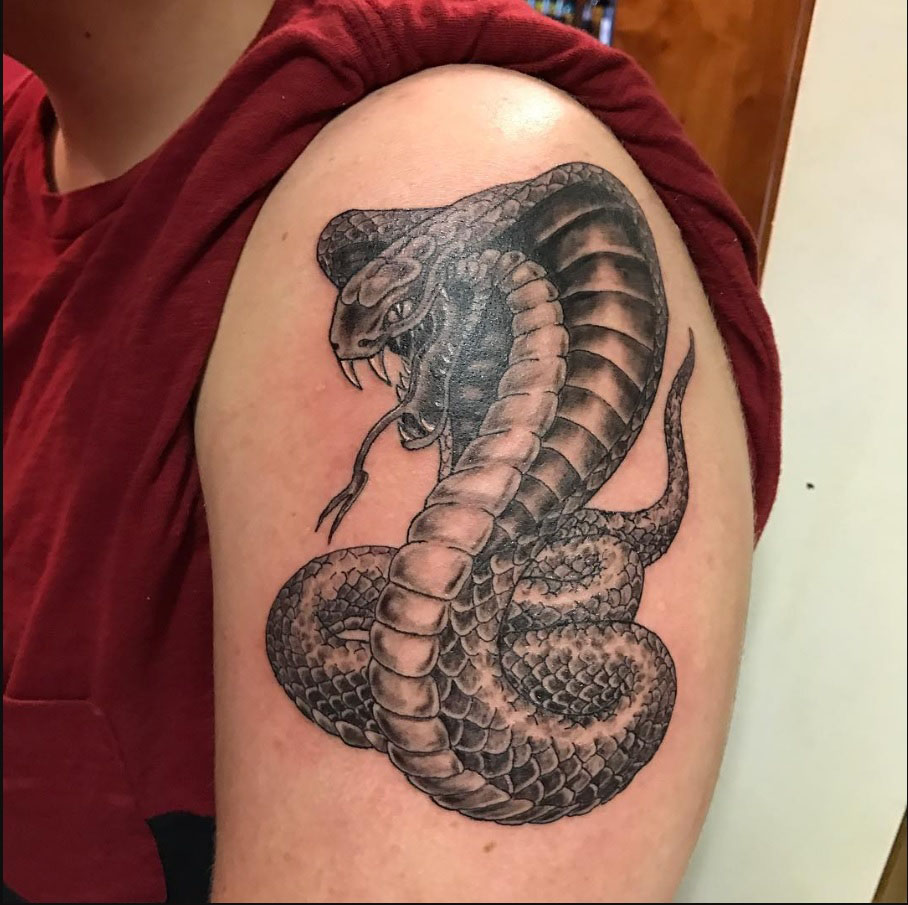
Minimalist Serpent Tattoos
Minimalist serpent tattoos are simple and understated, often featuring just the outline of a serpent or a small, minimalist design. These tattoos are an excellent choice for people who want a small and discreet tattoo that still has deep meaning.

Blackwork Serpent Tattoos
Blackwork serpent tattoos feature bold black lines and negative space to create striking and visually stunning designs. These tattoos are often done in a geometric or abstract style, making them a unique and eye-catching choice.
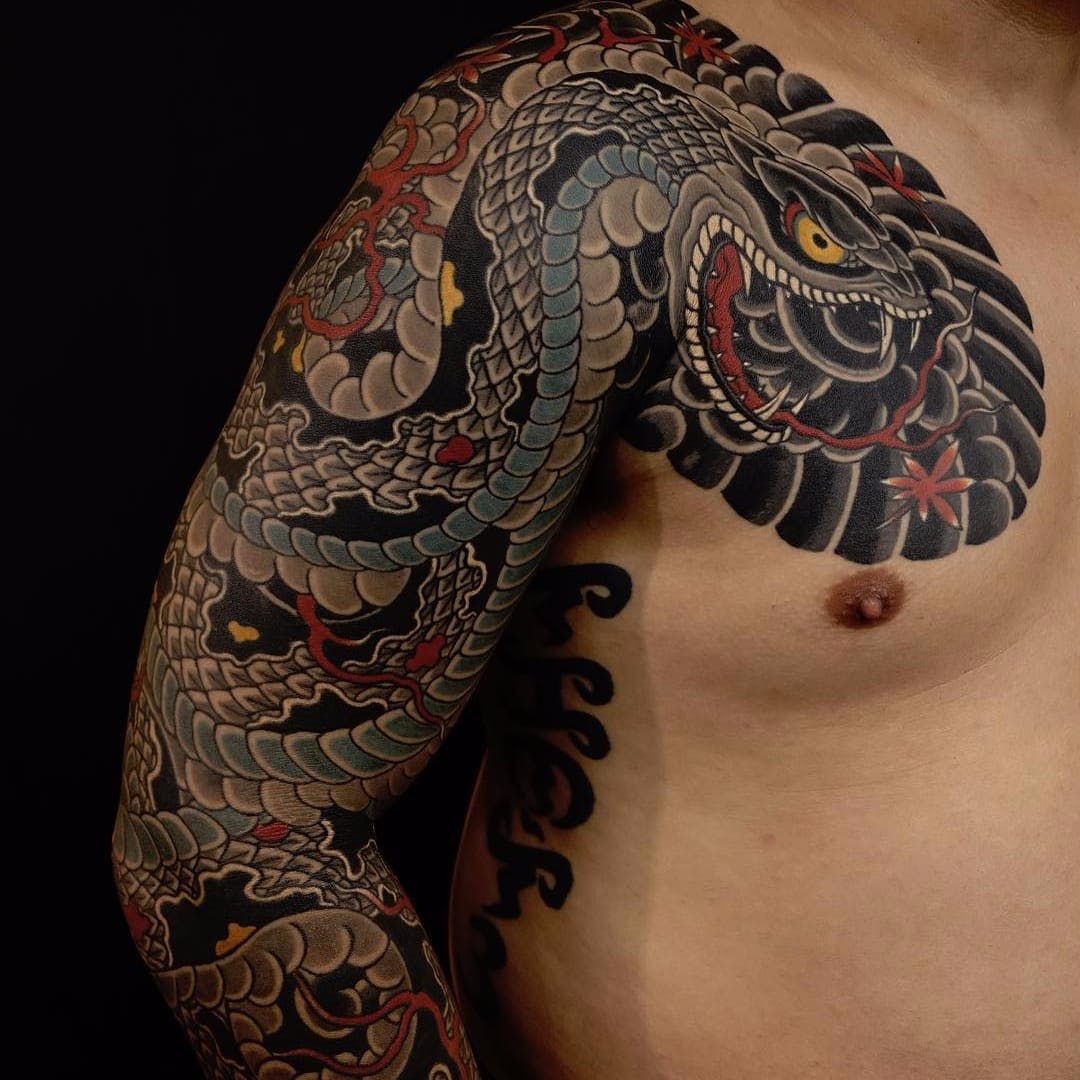
Comparisons of Serpent Tattoo Designs
When it comes to choosing a serpent tattoo design, there are several factors to consider, such as size, placement, and style. Here are some comparisons of serpent tattoo designs:
Realistic vs. Traditional
Realistic serpent tattoos are highly detailed and lifelike, while traditional serpent tattoos are bolder and more colorful. Both styles have their unique appeal, so it ultimately comes down to personal preference.
Large vs. Small
Serpent tattoos can be done in various sizes, from small and minimalist to large and intricate. Larger tattoos often have more details and complexity, while smaller tattoos are discreet and easy to cover up if needed.
Colorful vs. Blackwork
Colorful serpent tattoos feature bold colors and intricate designs, while blackwork serpent tattoos use negative space and bold black lines to create striking designs. Both styles can be visually stunning, so it depends on the individual’s taste.
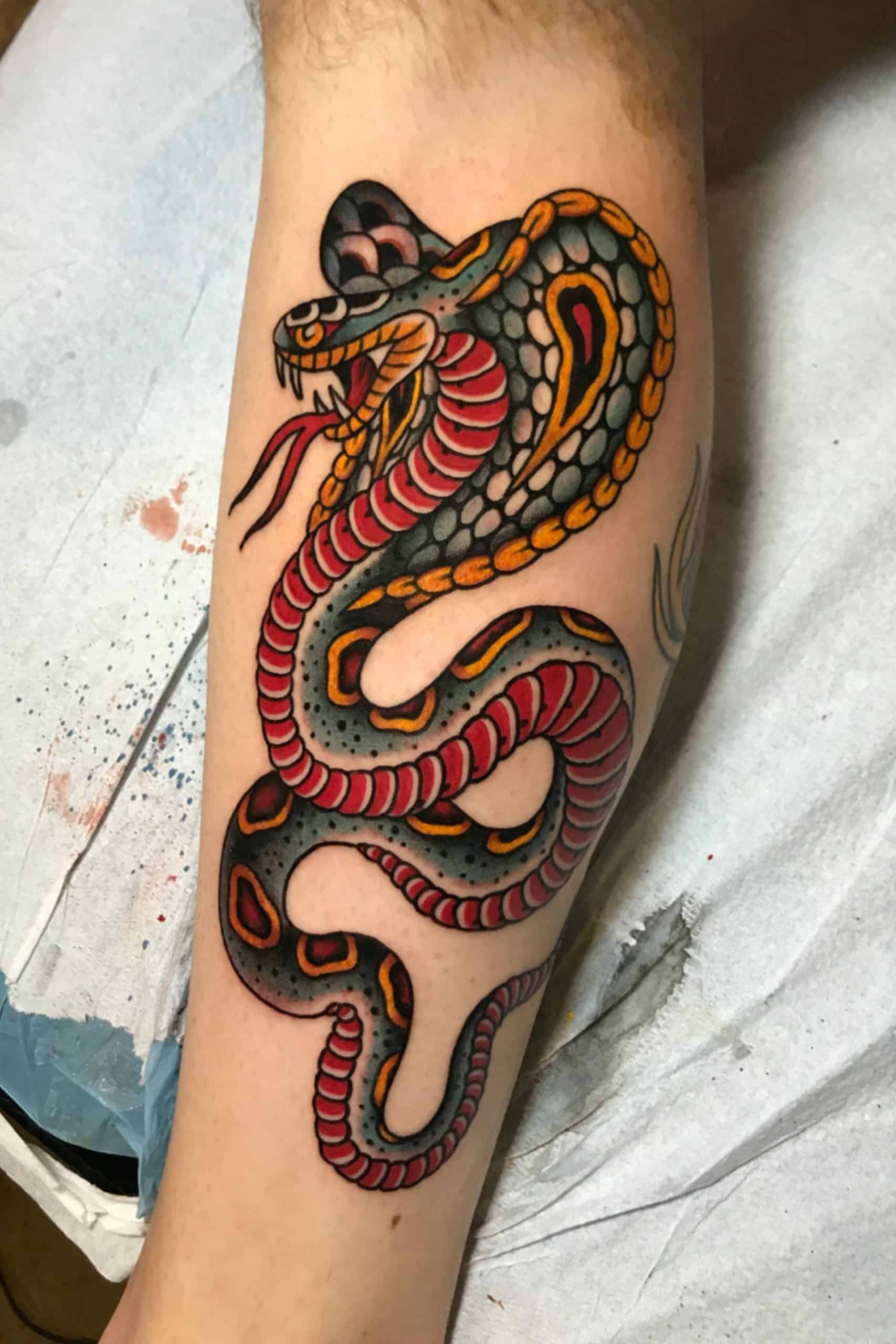
Conclusion
Serpent tattoos are a beautiful and meaningful choice for those who appreciate the rich history and symbolism behind them. From rebirth and renewal to wisdom and protection, serpents have been associated with various meanings across cultures and time periods. Whether you prefer a traditional, realistic, minimalist, or blackwork design, there’s a serpent tattoo out there to suit your style and preferences. By embracing the meaning behind your tattoo and taking care of it properly, you can enjoy your serpent tattoo for years to come.

I am Harvey Berry, a tattoo enthusiast who has immersed himself in the diverse world of ink, passionately exploring the beauty and artistry within each tattoo. My mission extends beyond uncovering the aesthetics of tattooing; it involves sharing in-depth knowledge across all aspects of this art form.
Fueled by genuine curiosity and love for every facet of tattooing, I have diligently crafted well-researched articles, with a special focus on the Tattoo Meaning of Impeccable Nest section. Here, my aim is to help the tattoo community gain a deeper understanding of the meanings and values embedded in each tattoo.
One of my primary goals is to encourage responsible decision-making when it comes to getting inked. I recognize that choosing to get a tattoo is a significant personal decision that requires careful consideration. Hence, I provide diverse resources covering the meaning of tattoos, the tattooing process, aftercare tips, and other valuable information.
Whether you are a seasoned tattoo enthusiast or embarking on your first exploration of the world of body art, I aspire to be a reliable resource for you at every step of your journey. I hope that my extensive knowledge of tattoos, especially in the Tattoo Meaning section, will assist you in finding inspiration to express yourself through the art of tattoos.
